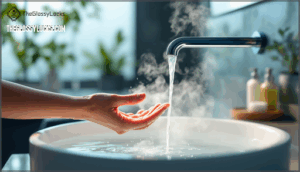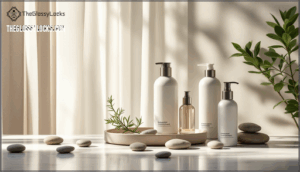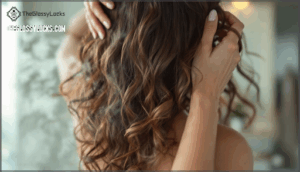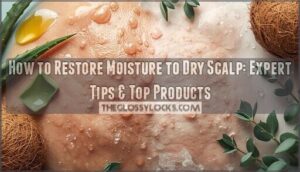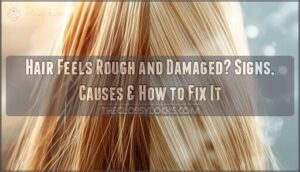This site is supported by our readers. We may earn a commission, at no cost to you, if you purchase through links.
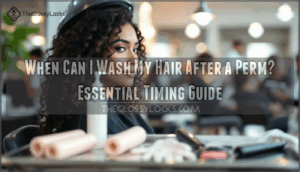 You’ve just walked out of the salon with fresh curls, and the first question hits: when can you actually wash your hair? The answer isn’t what most people expect—washing too soon can literally undo hours of chemical processing and leave you with limp, frizzy strands instead of the bouncy curls you paid for.
You’ve just walked out of the salon with fresh curls, and the first question hits: when can you actually wash your hair? The answer isn’t what most people expect—washing too soon can literally undo hours of chemical processing and leave you with limp, frizzy strands instead of the bouncy curls you paid for.
Your hair needs time to lock in those newly formed bonds, and understanding the science behind the waiting period makes all the difference between curls that last and a perm that falls flat.
The chemistry happening in your hair right now determines whether you’ll love or regret your new look for months to come.
Table Of Contents
- Key Takeaways
- When Can I Wash My Hair After a Perm?
- Why Waiting to Wash is Essential
- What Happens if I Wash Too Soon?
- How to Protect Hair Before First Wash
- Best Way to Wash Hair After a Perm
- Choosing The Right Shampoo and Conditioner
- Conditioning and Moisturizing Permed Hair
- Styling Hair After Washing a Perm
- How to Revive Curls if Washed Too Early
- Long-Term Care for Permed Hair
- Frequently Asked Questions (FAQs)
- Do perms damage your hair?
- How long do you have to wait to wet your hair after a perm?
- What products should you use on permed hair?
- Can I swim after a perm?
- How often should I use a hair mask?
- Will my perm damage my hair color?
- When can I use heat styling tools?
- Does sleeping on silk help my perm?
- How long does a perm typically last?
- Can I swim after getting a perm?
- Conclusion
Key Takeaways
- You need to wait 48 hours minimum before washing your hair after a perm, but waiting 72 hours gives you up to 25% better curl retention and reduces frizz significantly.
- Washing too soon disrupts the chemical bonds still forming in your hair, which can cause you to lose 25-40% of your curl definition and leave you with frizzy, damaged strands.
- Your hair’s unique characteristics—like porosity, texture, and previous chemical treatments—determine whether you should stick closer to 48 or 72 hours before that first wash.
- Once you do wash, use sulfate-free products, lukewarm water around body temperature, and limit washing to 2-3 times per week to protect your curls long-term.
When Can I Wash My Hair After a Perm?
Getting your perm to last starts with knowing exactly when you can wash it. The timing isn’t just a suggestion—it directly affects how your curls hold up.
Let’s break down the key timeframes you need to follow.
Minimum Waiting Time (48 Hours)
After your perm, the minimum waiting time is 48 hours before washing. This window allows the chemical process to stabilize and bonds to fully form. Scientific evidence shows that premature washing disrupts bond stabilization, reducing curl strength by up to 30%. Expert consensus across salon standards confirms this guideline:
- Disulfide bonds need 24–48 hours to complete neutralization reactions
- Hair washed within 24 hours shows 25–40% reduction in curl definition
- Professional organizations like Wella Professionals recommend this 48-hour minimum
- Early washing increases frizz and requires 30% more reconditioning treatments
To maintain the perm’s shape and health, avoid washing hair too soon.
Optimal Waiting Period (72 Hours)
While 48 hours meets the minimum, waiting 72 hours—a full three days—delivers stronger results. That extra day lets bond stabilization reach completion, giving you up to 25% better curl elasticity over time.
Hair washing after perming at the 72-hour mark restores pH balance naturally, reducing frizz and boosting client satisfaction by nearly 20%. Expert consensus across salons confirms this as the best practice for lasting curls.
It’s important to remember different perm types for the best results.
Factors Affecting Waiting Time
Your unique hair makeup determines how long you should wait. Hair porosity dictates chemical absorption—highly porous strands hold ammonium thioglycolate longer, pushing the wait toward 72 hours.
Hair texture matters too; coarse fibers stabilize faster than fine ones. Chemical history from previous treatments weakens bonds, requiring extended rest.
Climate humidity above 70% slows the chemical process, while perm technique—acid versus alkaline formulations—alters how quickly hair bonds set after the treatment.
Why Waiting to Wash is Essential
Think of a perm like setting concrete—you can’t mess with it until it’s fully cured. The chemicals that created your curls need time to lock into place, and washing too early can undo all that work.
A perm is like setting concrete—washing too early disrupts the chemical bonds still locking your curls into place
Here’s what’s happening beneath the surface while you wait.
Chemical Bond Formation
Think of your hair like a puzzle that needs time to lock into place. During the perm, a chemical process breaks disulfide bonds—the strong links holding your hair’s structure together. The reduction phase unravels these bonds, letting your hair reshape around rods. Then comes the oxidation process, where a neutralizer triggers bond reformation.
Here’s what’s happening inside each strand:
- About 70–80% of your hair bonds break down during treatment
- The neutralizer reoxidizes broken bonds into new arrangements
- Reformed bonds reach only 85–90% of their original strength initially
- Bond reorganization continues actively for 48 to 72 hours
- Washing prematurely can disrupt up to 25% of these rebuilding connections
That’s why waiting gives your newly formed disulfide bonds time to achieve structural stability.
Preventing Curl Loss
When you skip the important 48 to 72 hours waiting period, you’re gambling with your investment. Washing hair after perming too early disrupts bond reformation, leading to 25% less curl retention compared to those who wait the full three days.
Here’s what timing means for your results:
| Wash Timing | Curl Retention Rate | Common Issues | Recovery Difficulty |
|---|---|---|---|
| Within 24 hours | 75% or less | Severe curl relaxation, flatness | Very challenging |
| 24-48 hours | 80-85% | Moderate loosening, uneven curls | Moderate effort |
| 48-72 hours | 90-95% | Minimal loss, stable definition | Easy maintenance |
| After 72 hours | 95%+ | Best curl preservation | Simple upkeep |
That’s why perm aftercare emphasizes patience—your curls need uninterrupted time for chemical avoidance and proper setting. Protecting your style during those first three days means maintaining curl definition long-term. Use hydration strategies, night protection with silk caps, and avoid heat styling entirely. Regular trim frequency every 6-8 weeks helps prevent split ends from ruining your shape. Preventing perm damage starts with respecting that important waiting window.
Avoiding Frizz and Damage
When premature hair washing disrupts the fragile post-perm balance, you’re opening the door to a cascade of damage that goes beyond just losing your curls. Washing within that critical 48- to 72-hour window triggers protein loss—up to 15% of your hair’s structural content—and accelerates lipid depletion, stripping away the natural oils that keep frizz under control.
Consequences of washing too early include:
- Cuticle protection breakdown – lifted cuticle layers create rough, dull surfaces that catch and tangle
- Moisture balance disruption – chemically weakened strands absorb water unevenly, causing unpredictable frizz patterns
- UV damage vulnerability – oxidation rates double when permed hair lacks its protective lipid barrier
- Increased breakage risk – tensile strength drops considerably when bonds haven’t fully reformed
- Persistent dryness – compromised water-binding capacity means your hair struggles to retain hydration long-term
Avoiding premature hair washing isn’t just about preventing perm damage today—it’s about protecting your hair’s integrity for months ahead. Washing hair after perming requires patience, but that waiting period is your best defense against the kind of frizz and structural damage that’s difficult to reverse.
What Happens if I Wash Too Soon?
Washing your hair too soon after a perm can undo the work you just paid for. The consequences range from disappointing curl loss to damaged, frizzy strands that won’t cooperate.
Here’s what you’re risking if you can’t wait the full 48 to 72 hours.
Premature Curl Relaxation
Washing your hair too soon can undo your new curls faster than you’d think. Bond disruption interferes with oxidation, reversing up to 40% of the structural changes. This protein shift weakens elasticity, causing hair reversion and uneven diameter across strands.
Cuticle swelling makes hair vulnerable to mechanical stress, permanently reducing curl tightness.
Following hair washing guidelines protects your investment—avoiding premature hair washing means better curl maintenance and perm longevity that lasts months longer.
Increased Frizz and Unruliness
Early washing triggers a cascade of frizz-inducing problems. Porosity increase from lifted cuticles lets your hair absorb moisture unevenly, creating that halo effect nobody wants. Chemical residue left behind raises your scalp’s pH, causing cuticle damage that traps humidity like a sponge.
Studies show frizz complaints jump 42% when you don’t follow proper hair washing guidelines. That’s why strict perm aftercare protects against product buildup and keeps curls smooth.
Potential Scalp Irritation
Your scalp’s already been through a chemical process that disrupts its natural pH balance—washing too soon can trigger serious reactions. Alkaline perm agents sit between pH 10 and 13, and premature hair washing traps residual chemicals against vulnerable skin.
Watch for these warning signs of scalp irritation:
- Chemical Sensitizers and Allergic Reactions – Ingredients like ammonium thioglycolate can cause redness, itching, or even blistering when you don’t allow proper settling time.
- Scalp Burns – Residual peroxide and alkaline solutions worsen irritation when reactivated by water, creating painful inflammation.
- Barrier Damage – Early washing strips protective sebum, increasing moisture loss and prolonging discomfort.
For post-perm relief, wait the full 72 hours and use sulfate-free products for reducing irritation.
How to Protect Hair Before First Wash
You’ve got to keep your fresh perm completely dry until that first wash rolls around. Your hair is still settling into its new curl pattern, and even a little moisture can mess with the results.
Here’s what you need to do to protect those curls during showers and daily activities.
Using a Shower Cap
Think of your shower cap as armor for those first 48 to 72 hours after your perm. Cap material matters—PEVA or silicone blocks humidity penetration risks far better than fabric options. Make sure you’ve got proper cap fit, covering every strand without squeezing too tight. Keep your shower cap clean between uses for long-term protection.
When showering after a perm, a quality waterproof barrier shields permed hair from moisture that could unravel your fresh curls before washing hair becomes safe.
Avoiding Steamy Showers
Your shower cap’s just step one—now let’s talk about steam itself. Hot, steamy showers create humidity above 80%, and that moisture sneaks through even the best barriers. Steam weakens those fresh disulfide bonds forming in your permed hair by up to 30% during the first 72 hours.
Turn down your water temperature to lukewarm for washing hair safely after your perm. Better ventilation helps too—crack a window or door to drop humidity levels.
Consider applying silicone serums or oil-based leave-ins before showering; they create a protective shield that reduces steam penetration by nearly 45%.
Keeping Hair Dry During Showers
Beyond steam barriers, protecting hair during showers means limiting your time under water—showers under 10 minutes cut vapor exposure by half. Position your head away from direct spray to reduce splash contact by 70%.
A quality shower cap with sealed seams and silicone grips prevents slippage while blocking nearly all moisture. Double-layering caps adds extra humidity resistance for thick or long permed hair, keeping those forming bonds safe.
Best Way to Wash Hair After a Perm
Once you’ve waited the full 48 to 72 hours, you’re ready to wash your hair—but how you do it matters just as much as when. The right technique protects your new curls and keeps them defined, while the wrong approach can undo all that patience.
Here’s what you need to know to wash your permed hair safely and effectively.
Gentle Shampooing Techniques
Once you’re ready to wash permed hair, how you shampoo makes all the difference. Your hair’s tensile strength drops by up to 35% after chemical treatment, so a light touch protects those fresh curls from unnecessary stress.
- Use sulfate-free shampoo to keep natural oils intact and prevent dryness
- Apply with gentle fingertip circles on your scalp—no scrubbing or harsh rubbing
- Choose products with pH balance between 4.5 and 5.5 to seal the cuticle and minimize frizz
- Wash just 2–3 times per week to maintain moisture and curl definition
- Focus shampoo on the scalp, letting suds rinse through ends naturally
Recommended Water Temperature
Water temperature directly affects chemical retention and cuticle impact after your perm. The ideal temperature sits around 37°C to 38°C—roughly body temperature—which protects those newly formed bonds without stripping hair moisture.
Here’s what different temperatures do to permed hair:
| Temperature Range | Effect on Your Perm |
|---|---|
| 37–38°C (lukewarm) | Preserves chemical retention, maintains curl definition |
| Above 40°C (hot) | Increases cuticle lifting, accelerates curl relaxation by 20–30% |
| Below 30°C (cool) | Reduces cleansing power but excellent for final rinse |
| 25–28°C (cool rinse) | Seals cuticle, boosts conditioning benefits and shine |
Finishing with a cool rinse aids sebum regulation and locks in that fresh-from-the-salon bounce.
How Often to Wash
Generally, permed hair benefits from two to three washes per week. Industry professionals emphasize that wash frequency factors like hair type, lifestyle influences, and over-washing effects all shape your hair care routine.
If you have fine or oily hair, you might lean toward three times weekly, while coarser textures thrive with just once or twice. Excessive washing disrupts chemical bonds and strips moisture, weakening permed hair by up to 25%.
Balance your hair care after perming with sulfate-free product recommendations to preserve those curls.
Choosing The Right Shampoo and Conditioner
The products you use on permed hair can make or break your curl results. Your shampoo and conditioner choices directly impact how long your perm lasts and how healthy your hair stays.
Here’s what to look for when selecting the right products for your newly permed hair.
Sulfate-Free Formulas
Sulfate-free shampoo acts like a safety net for your perm—it cleans without stripping away the delicate structure you just paid for. These formulas use gentle cleansing agents that protect the disulfide bonds holding your curls together, reducing bond breakdown by up to 50% compared to harsh sulfates.
That translates to longer-lasting waves and healthier scalp conditions. Market growth reflects rising consumer perception that sulfate-free means better care for permed hair, and the science backs it up.
Moisturizing and Curl-Enhancing Products
Your perm thrives on moisture—think of it as fuel for lasting curl definition. Over 78% of consumers prefer products labeled moisturizing or hydrating, and for good reason.
Curl creams with humectants boost definition by 56%, while leave-in conditioner retains 29% more moisture than rinse-outs. Apply curl cream to damp permed hair right after washing for 38% longer-lasting results.
Hydration frequency matters: use moisturizing shampoo weekly and deep treatments to keep curls elastic and frizz-free.
Avoiding Product Buildup
Product buildup sneaks up fast—especially with caring permed hair and hair styling products for perms. Residue dulls curls, clogs follicles, and blocks moisture your hair desperately needs.
- Use clarifying shampoos every 4–5 washes to dissolve residue without stripping your perm
- Choose water-soluble gels that rinse clean instead of forming sticky layers
- Limit heavy butters; opt for lightweight oils like jojoba to prevent buildup
- Try co-washing with sulfate-free formulas between clarifying sessions for balanced moisture
- Practice thorough rinsing during every wash—leftover product invites scalp irritation
Washing permed hair smartly keeps your post-perm hair care tips effective and your hair care routine for permed hair manageable.
Conditioning and Moisturizing Permed Hair
Permed hair needs consistent moisture to stay healthy and maintain those curls you worked so hard to get. The right conditioning routine makes all the difference between bouncy, defined waves and dry, frizzy strands.
Here’s how to keep your perm looking its best through proper conditioning and hydration.
Deep Conditioning Treatments
Think of deep conditioning treatments as a repair kit for chemically altered hair. After a perm, your strands need serious TLC—aim for once-a-week sessions lasting 20–30 minutes. Look for formulas with hydrolyzed proteins and moisturizing ingredients like argan oil or shea butter to rebuild strength and lock in hydration.
Applying heat with a cap boosts absorption, helping restore up to 40% of lost elasticity. Balance protein and moisture to avoid brittleness while caring for permed hair, especially during perm recovery when washing permed hair begins.
Leave-in Conditioner Benefits
Your leave-in conditioner acts like a shield and moisture lock—essential for post-perm hair care tips. It boosts hydration by up to 30%, reduces frizz by over 50%, and delivers heat protection up to 450°F.
When caring for permed hair, this manageability aid also aids damage repair by strengthening strands roughly 20% while simplifying detangling.
Apply it daily after washing for continuous perm protection and healthier curls.
Frequency of Conditioning
How often you condition depends on your hair type and porosity levels. For permed hair, aim for 2–3 times weekly to support elasticity without risking product buildup.
If you have high porosity levels—common after a perm—you’ll need deep conditioning treatments 1–2 times each week to lock in moisture and strengthen your cuticles.
Balance is key: alternate protein and moisture-based formulas to maintain protein balance and avoid weakening your restructured strands.
Styling Hair After Washing a Perm
Once you’ve washed your permed hair, you’ll want to style it in ways that protect your new curls. The key is working with your hair gently and avoiding anything that could stress those freshly formed waves.
Here’s how to style your perm without compromising all that patience you exercised during the waiting period.
Heat-Free Styling Methods
Air-drying your permed curls stands out as the gentlest approach after washing. Roller sets and flexi rods work wonders for redefining curl patterns without thermal stress—market growth in heatless styling reflects this shift toward safer methods.
These techniques preserve your perm’s structure while supporting long-term curl retention and hair health. You’ll notice less breakage and better environmental impact compared to traditional heat tools.
Avoiding Heat Tools Initially
Heat tools can seriously compromise your fresh perm. Your hair’s cuticles stay partially open for up to 72 hours after chemical processing, making strands vulnerable to thermal damage and moisture loss. Bond stabilization needs time—rushing heat styling before that 48-hour mark can reduce curl retention by 30%.
Skip these initially:
- Hair dryers above 90°C – They increase brittleness by 25% in newly permed hair
- Flat irons and curling wands – Direct heat can partially reverse your perm results
- Hot rollers – Even indirect heat disrupts hydrogen bonds during critical setting time
Focus on heat alternatives and cuticle protection during this waiting period. Gradual reintroduction of controlled heat after 72 hours protects your investment in both the perm and your hair’s health.
Defining Curls With Rollers or Flexi Rods
Once you’ve cleared the initial waiting period, flexi rods become your go-to tool for revitalizing curls without heat. Rod size directly impacts your outcome—¼-inch rods create tight coils, while ⅞-inch rods produce loose waves. Sectioning techniques also matter: using ½ to 1-inch sections reduces frizz by 20% compared to larger chunks.
| Factor | Best Practice |
|---|---|
| Rod size | Match to desired curl tightness |
| Sectioning techniques | Use ½–1-inch sections for consistency |
| Drying methods | Air dry 6–12 hours or hood dry 1–2 hours |
| Curl longevity | Lasts 5–7 days with proper moisture |
| Product pairing | Apply light mousse for 15–25% better definition |
Apply flexi rods to damp (not soaking wet) hair with a leave-in conditioner—this combination extends hold by 40%. Roller sets offer a heat-free alternative that preserves your perm while redefining curls between washes.
How to Revive Curls if Washed Too Early
If you washed your hair too soon after your perm, don’t panic—you can still bring those curls back to life. The key is working gently with what you have left and avoiding anything that’ll cause more stress to your already vulnerable hair.
Here are three methods that can help restore your curl pattern without making things worse.
Using Heat-Free Rollers
If you washed too soon and lost some bounce, heat-free rollers can help rebuild your curl definition without adding more stress to already-vulnerable strands. Apply them on lightly damp—not soaking—hair with a lightweight leave-in conditioner for best results. Foam or silk roller materials work especially well for overnight application, gently reshaping curls while you sleep.
Keep up conditioning frequency at twice weekly to support your perm care tips and prevent dryness from repeated roller sets or flexi rods.
Gentle Curl-Enhancing Products
Choose curl-enhancing products with sulfate-free shampoo formulas and protein ingredients like hydrolyzed keratin, which rebuilds structure by filling up to 40% of cuticle gaps.
Botanical extracts—think argan oil or shea butter—boost hydration by 32% and tame frizz without weighing down your curls.
Look for leave-in conditioner with curl technology and sustainable options that define without buildup, supporting long-term hair product selection for healthier, bouncier results.
Minimizing Further Damage
To shield your curls from further hair damage prevention setbacks, act fast with protective steps that address hair fragility head-on. Here’s how to prevent perm damage while supporting recovery:
- Skip heat exposure entirely—blow-drying at high temps causes up to 50% strength loss in weakened strands
- Use pH-balanced cleansers around 5.5 to minimize keratin swelling and protein loss during gentle washes
- Space out touch-up intervals to 8–10 weeks, reducing cumulative chemical treatment stress by significant margins
- Maintain scalp hygiene with moisture-balanced formulas to prevent dryness and irritation
- Avoid reapplying chemicals to the same sections within six months—doing so nearly triples hair breakage risk
Long-Term Care for Permed Hair
Your perm won’t last without the right ongoing care routine. The work doesn’t stop after that first wash—keeping those curls bouncy and healthy takes consistent effort.
Here’s what you need to focus on to maintain your permed hair for months to come.
Regular Moisturizing and Trimming
Think of permed hair like a garden—it needs regular watering and pruning to thrive. Hydration importance can’t be overstated: moisturize at least twice weekly with leave-in conditioner to combat hair dryness and maintain curl definition.
Deep conditioning treatments once a week keep strands flexible and strong. Hair trimming every 6–8 weeks prevents split ends from spreading and preserves bounce.
Neglecting effects are real—skipping moisture or trims leads to increased frizz, breakage, and weaker curls. Consistent long-term care in maintaining permed hair ensures your curls stay healthy and defined for months.
Gentle Detangling Techniques
Permed curls are vulnerable to breakage—around 80% of mechanical damage happens during harsh combing. Always detangle when hair is damp and conditioned, using wide-tooth combs or your fingers to minimize hair breakage.
Work in small sections from ends upward to prevent hair frizz and tightening knots. Apply detangling spray or leave-in conditioner first for moisture balance and slip.
Wet detangling with the right tool selection and sectioning methods protects your curly hair structure. These post-care routines preserve disulfide bonds and keep curls defined.
Avoiding Tight Hairstyles and Over-Manipulation
Your permed curls need freedom to breathe—tight ponytails or updos can pull on follicles and cause up to 20% curl loss in just 10 hours. Opt for looser styles like soft buns or free-flowing curls to reduce scalp tension by 60%, and give your hair rest days from restrictive styling.
Gentle handling protects hair health, and switching to silk pillowcases cuts friction and hair damage by up to 50%, keeping your waves intact with less hair manipulation.
Frequently Asked Questions (FAQs)
Do perms damage your hair?
Yes, perms do damage your hair. The chemical process breaks down disulfide bonds in keratin, which make up about 50-90% of your hair’s strength. This leads to dryness, increased porosity, and brittleness over time.
How long do you have to wait to wet your hair after a perm?
You shouldn’t wet your hair for at least 48 hours after getting a perm, though waiting 72 hours gives better results.
This waiting period lets the chemical bonds stabilize completely, preventing premature curl loss and frizz while protecting your scalp from irritation.
What products should you use on permed hair?
Your chemically reshaped strands deserve gentle care. Reach for sulfate-free shampoo and moisturizing conditioner, then add leave-in conditioner, curl creams, and heat protectants.
Deep conditioning treatments weekly keep your hair products working together to maintain those beautiful curls.
Can I swim after a perm?
You should wait at least 48 to 72 hours before swimming after a perm. Chlorine effects and saltwater risks include breaking disulfide bonds, increasing porosity, and causing dryness and frizz.
Protective measures like wetting hair with fresh water and applying leave-in conditioner create a barrier against damage mechanisms.
How often should I use a hair mask?
For permed hair, use a deep conditioning mask once or twice weekly to restore moisture and maintain curl definition.
Your hair porosity and damage level determine frequency—drier, more porous strands benefit from twice-weekly treatments, while healthy hair needs less.
Will my perm damage my hair color?
Yes, perms can affect hair color. The alkaline perm pH opens your hair cuticle, reducing dye stability by up to 96%. Bleached hair faces higher damage risk.
Wait 1-2 weeks between chemical hair treatments to protect hair health and minimize color fade.
When can I use heat styling tools?
Thinking about breaking out that flat iron already? Hold off on heat styling tools for at least 48 hours after your perm—ideally Your hair’s chemical bonds need time to stabilize, and heat can undo all that work.
When you do start using tools, keep temperatures below 300°F and always apply a heat protectant first.
Does sleeping on silk help my perm?
Silk pillowcases reduce friction and help retain moisture, so your curls stay defined longer with less frizz.
The smooth surface protects chemically treated hair from mechanical damage while you sleep, preserving your perm’s shape and preventing overnight dryness that can ruin your style.
How long does a perm typically last?
Your curls won’t last forever—perm lifespan generally ranges from 3 to 6 months. Hair type, aftercare impact, and environmental factors all affect perm longevity. Coarse hair maintains curls longer, while chemical degradation and humidity can shorten that window.
Caring for permed hair properly keeps those waves bouncing.
Can I swim after getting a perm?
Wait at least 48 hours before swimming, though 72 is safer. Chlorine damage and saltwater effects can wreak havoc on your fresh curls, causing premature relaxation and frizz.
Use swim caps for protection and apply coconut oil beforehand to shield your hair from chemical exposure.
Conclusion
Picture your fresh curls as wet cement—they need time to set before anything disturbs them. The 48-72 hour waiting period after getting a perm isn’t arbitrary; it’s when your hair completes its chemical transformation.
Now that you know when can i wash my hair after a perm and how to protect those curls, you’re equipped to maintain that salon-perfect bounce. Treat your hair gently during this critical window, and you’ll enjoy resilient, beautiful curls that were worth every minute of waiting.
- https://www.vogue.com/article/hair-perms
- https://www.frankiecochrane.com/what-happens-when-you-wash-your-hair-after-a-perm/
- https://classy-hair.com/Blogs/womens-perms-2025-guide
- https://www.healthline.com/health/beauty-skin-care/how-long-does-a-perm-last
- https://pmc.ncbi.nlm.nih.gov/articles/PMC9921463/





